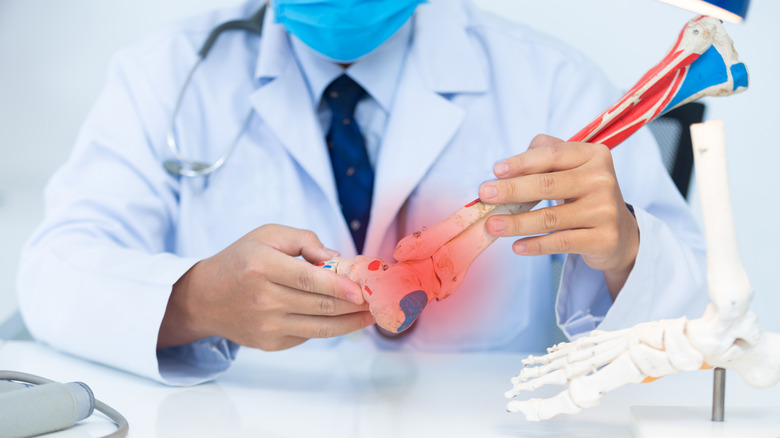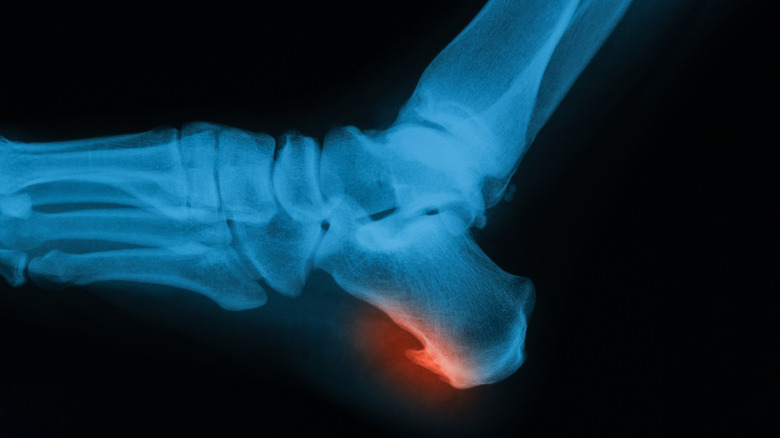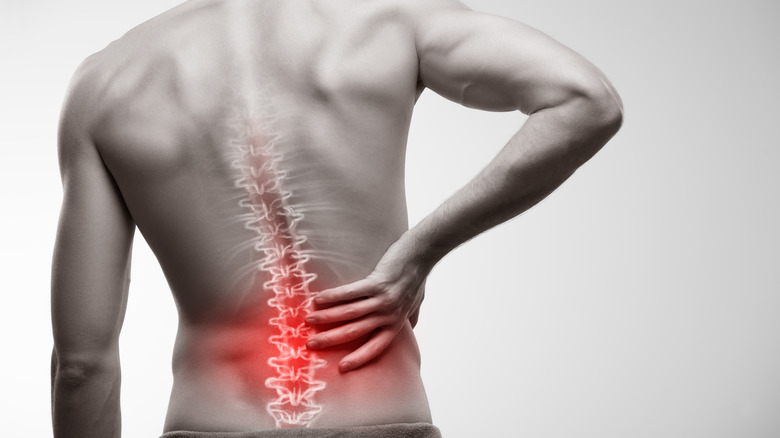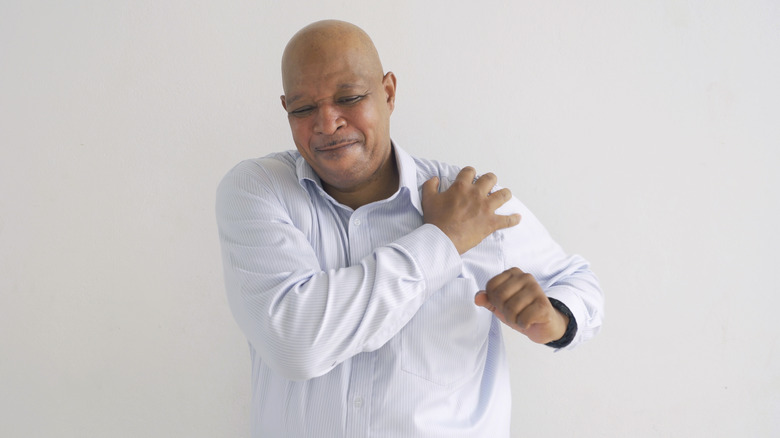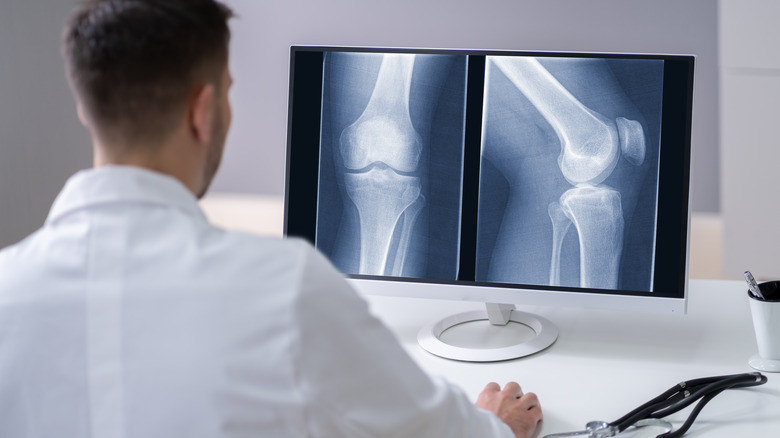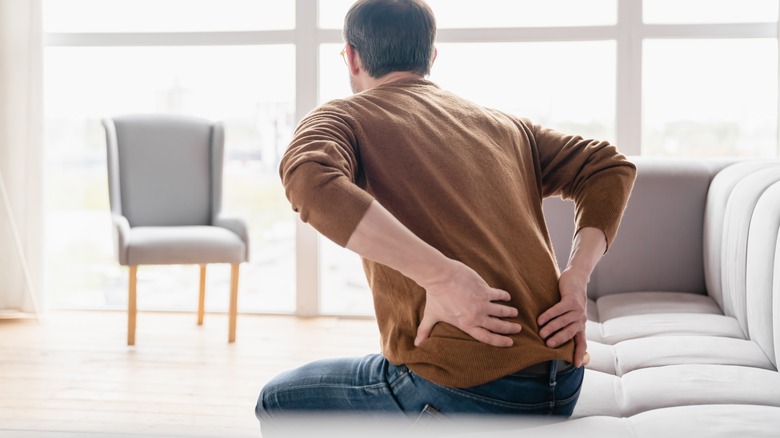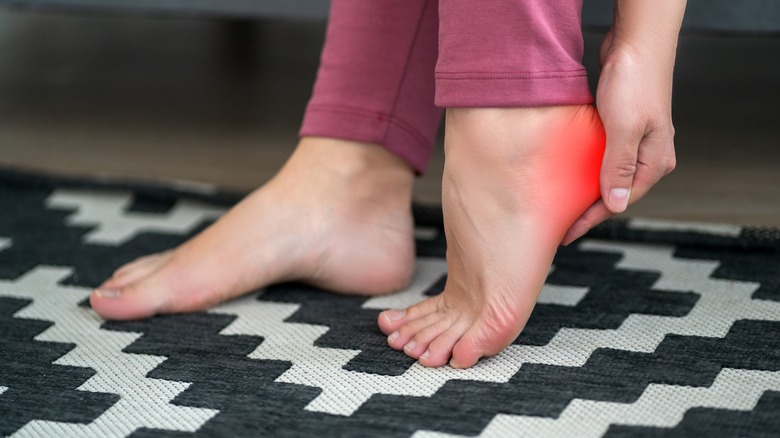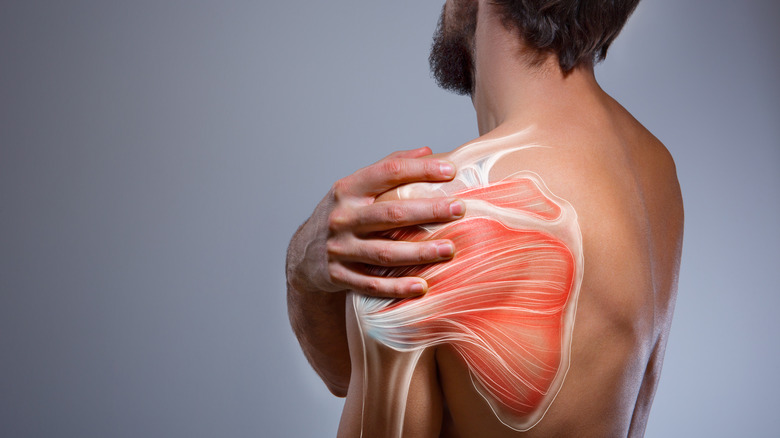Bone Spurs Explained: Causes, Symptoms, And Treatments
You might imagine something sharp, pointy, and probably painful when you think of a spur in any part of the body. But bone spurs are smooth lumps of bone that grow on other bones. Bone spurs usually appear as we grow older, and they take time to form (via Cedars Sinai). A bone spur seems like something you'll be able to feel or see. But foot and ankle surgeon Christopher Toth explains to Banner Health that this isn't always the case. Many bone spurs grow in line with the body and will not be visible. Indeed, Toth even states that "Everyone has bone spurs." They are a common finding in X-ray scans. But they are ignored if they don't cause any symptoms and, therefore, don't need to be worried about.
According to the Cleveland Clinic, bone spurs are mostly seen in adults older than 60 years, but they can be found in younger people as well. Bone spurs can be formed on any bone, typically close to a joint. However, most bone spurs are found on bones of the spine, shoulder, fingers and other parts of the hand, hip, knee, heel, big toe, ankle, and other parts of the foot. To reduce your chances of developing bone spurs, you should keep fit, maintain a healthy weight, eat a balanced diet, exercise carefully to avoid joint injuries, maintain a good standing and sitting posture, and avoid damaging shoes in favor of well-fitting, comfortable ones. Unfortunately, you can't totally control whether bone spurs will develop.
How are bone spurs formed?
It seems strange that new bones can grow on other bones even when they shouldn't. But like every other body part, bones are made of cells — and sometimes due to injury or just natural aging, the body will build up new bone matter from cells, just like it does when it repairs fractured bones (via the Comprehensive Spine Institute). According to a review published in the Journal of Orthopedic Surgery, bone spurs develop from cartilages. These cartilages are then transformed from within into bone. Once the spurs are formed, they are integrated with the bones they grow out of.
Damage to a bone triggers the formation of most bone spurs. While trying to repair damage to a bone, the body may add some extra bone. Bone damage could be from bone bruises or injuries, wear and tear, or excessive stress. As Spine-Health explains, scientists believe bone spurs form to prevent excessive movement of a joint and to help the original bone bear weight. In this way, bone spurs reduce the stress on a joint and protects it from further damage. However, the Stone Clinic notes that this might not really be a good thing, as a bone spur could cause serious harm to a joint. But the site acknowledges that the fact the bone spurs are able to form means that it's possible to induce the growth of new bones where they would totally be useful — and scientists have been studying a technique for doing this, known as articular cartilage paste grafting.
Types of bone spurs
Bone spurs can be differentiated based on where they form on the bone. Bone spurs that form at the edges of where two bones meet at a joint are known as osteophytes (via Sports-Health). Another group of bone spurs are known as enthesophytes. They usually form at the site where tendons and ligaments attach to bones. Tendons connect muscles to bones, and ligaments connect two bones at a joint. Enthesophytes can also form where other connective tissues like fascia and joint capsules attach to bones.
Bone spurs can also be classified based on whether they are located outside or within the spine. Bone spurs outside the spine (also called extraspinal) can be found around different joints. They could grow into joints or on the outer margins of joints, according to a review published in the Journal of Orthopedic Surgery. The bone spurs within the spine — known as vertebral bone spurs — can be seen on its outer surface or inward, facing the spinal canal. They may also form around disks that cushion the bones of the spine, or around facet joints between these bones (via Miami Neuroscience Center).
Symptoms of bone spurs
Many people who have bone spurs won't realize that they have them. According to Cedars Sinai, just about 40% of people experience symptoms from bone spurs that need treatment. Some bone spurs are a problem because they affect nearby body structures, causing a variety of potential symptoms. Any symptoms you experience will depend on where the offending bone spur is located, says the Mayo Clinic. Bone spurs in the hip or knee might cause pain when you move and limit your movement. If they are in your spine, they might make your arms and legs feel weak or numb. Cedars Sinai adds that you might also notice a dull pain along your spine that gets worse when you move. And the pain might radiate to your shoulders, buttocks, or thighs. A sensation of pins and needles in the hands or feet is also a symptom of spinal bone spurs. Pain, swelling, stiffness, and difficulty moving are noticed when bone spurs form on the foot, shoulder, or hand (via Integrity Spine & Orthopedics)
It's hard to tell whether you have bone spurs based solely on what symptoms you experience. They could be signs of another medical condition. Healthline advises that you see your doctor if you feel pain in a joint, or if any joint swells or becomes stiff and doesn't get better within two days even after resting or applying ice.
Why do some bone spurs hurt so much?
A piece of bone sticking out where it shouldn't be seems like something that should hurt a lot. But that's not always the case. Many bone spurs are innocent, as they don't affect any nearby structures or cause any problems. The bone spurs that cause discomfort or pain irritate surrounding structures like soft tissues, nerves, or other bones. Over time the consistent irritation can lead to inflammation or cause the tissues to wear away and break down (via Integrity Spine & Orthopedics).
Painful bone spurs are often found in the spine, and they can cause discomfort for different reasons. If they grow into the spinal canal, they could narrow it out and compress the spinal cord. Bone spurs that form around the small openings (foramen) in the spine could compress nerves leaving the spinal cord through these holes. Because bone spurs formed in these locations could affect the spinal cord or nerves, they cause pain or tingling even in the arms or legs. Another place where spinal bone spurs could grow and cause pain is around joints of the spine, known as facet joints (via Deuk Spine Institute and Spine-Health).
How are bone spurs diagnosed?
To be certain that the symptoms you experience are caused by a bone spur, you need to get evaluated by your doctor. Your primary care physician may refer you to either an orthopedist or a rheumatologist (via WebMD). Your doctor will ask you questions about your symptoms and medical history, and may also perform a physical exam to find the source of pain and check how your joints move (via the Spine Institute of Nevada). Your doctor may also request a scan such as an X-ray, computed tomography (CT), or magnetic resonance imaging (MRI) to see your bone spurs and how other structures like ligaments, tendons, nerves, or spinal discs are affected by it. They also use scans to check for other problems like arthritis, infections, or fractures. Your doctor may perform tests known as electrodiagnostics to find out if spinal bone spurs are impacting your spinal cord or nerves.
Most bone spurs are caused by joint damage from osteoarthritis
Anyone can grow a bone spur. But if you have certain conditions, your chance of growing one increases. In most people, bone spurs develop as a result of joint damage from a type of arthritis known as osteoarthritis or from degenerative joint disease (via WebMD). Osteoarthritis and the related bone spurs usually affect older people. Osteoarthritis is caused by the wearing away and breaking down of the cartilage that covers and protects two bones where they meet at a joint. The bones begin to rub against each other, causing the joint to get inflamed, swell, and become painful. The body is stimulated to grow bone spurs because of the inflammation and added stress on the joint. It's how the body attempts to restore the joint to what it once was (via Integrity Spine & Orthopedics).
Other conditions can damage the joints and cause bone spurs. A sports injury or an accident that affects your joints can cause your body to grow a bone spur as it tries to heal the injury. You may also have a higher risk of bone spurs if you have an autoimmune disease like psoriatic arthritis, rheumatoid arthritis, or lupus (via Atlanta Spine).
Other causes of bone spurs
Your bones are bound to wear away and grow spurs as you age. And the chances increase if you take a lot of damage to your bones and surrounding soft tissues (via Pain Resource). If you use certain body parts repeatedly — perhaps because you run a lot, or type on the computer every day — you also have a higher risk of developing a bone spur. Some people are more likely to develop a spur because of their diet, or because they have genes that make them prone to bone problems. People who are obese have added stress on their bones, which can cause a spur (via the Comprehensive Spine Institute).
Enthesophytes (bone spurs around soft tissues) can form in response to certain conditions. In the spine, bone spurs can form around ligaments that get inflamed as a result of instability of the spine. This can be caused by degenerative disk disease, long-term stress on the spine, injury, or inflammation caused by another condition (via Spine-Health). A common place for enthesophytes to grow is on the heel. These spurs form when the plantar fascia or Achilles tendon gets inflamed, leading to plantar fasciitis and Achilles tendinitis, respectively. Since these tissues are attached to the heel bone, inflammation in those areas can contribute to a spur (via Sports-Health).
Bone spurs in athletes
If you are an athlete, you may frequently twist, turn, and manipulate different parts of your body to play your sport well. And bone spurs may form around joints you use a lot. For example, in a study published in Osteoarthritis and Cartilage, bone spurs were found to be more common in the knees of young, active athletes than non athletes between 18 and 36 years. Bone spurs can also form on the ankles of athletes who need to forcefully flex their ankles up or down — so those who participate in running, ballet, soccer, football, and volleyball are at particular risk. Some athletes don't develop any discomfort from having an ankle bone spur. But older athletes (above 25) might develop pain in their ankles as a result of bone spurs squeezing nearby soft tissues. This condition is known as ankle impingement or athlete's ankle (via SportsMD.com). Another place where athletes who participate in sports like baseball, tennis, and golf are likely to get bone spurs is on the shoulders, due to repeated stress on that point. Some people who have spurs in their shoulders experience pain, swelling, and numbness (via Healthline).
Treatment options for bone spurs
If you are experiencing any symptoms such as pain because of your bone spur, you need to get it treated, says Edward Santos, a spine surgeon who spoke to Summit Orthopedics. If left untreated for a long time, bone spurs can lead to permanent damage. Spurs that don't cause discomfort don't require treatment, however.
Treatment usually starts with the non-surgical approach. And the goal is to relieve pain and prevent further damage, says U.S. Pharmacist. Your doctor might prescribe injections containing corticosteroids, or advise you to take over-the-counter non-steroidal anti-inflammatory drugs (NSAIDs) like ibuprofen or naproxen to reduce pain and inflammation. Also, your doctor might perform a rhizotomy to burn a nerve transmitting pain signals, according to the Miami Neuroscience Center. Other forms of therapy like acupuncture, chiropractic treatment, and physical therapy might be performed.
Bone spurs can also be removed through surgery when your doctor deems it necessary. Your surgeon may make small incisions around the site of the bone spur to remove it, per My Health Alberta, or your procedure might be an open surgery which uses a large incision. Surgery will likely relieve your symptoms and you will be able to bounce back to your activities after your recovery.
Home care for bone spurs
There are some things you can do to relieve your symptoms outside the hospital. Applying an ice pack at intervals can get you some relief. You can also soak a cloth in apple cider vinegar and wrap it around the offending area. Since ginger is a good antioxidant and anti-inflammatory agent, you can try taking ginger regularly to get some relief (via Planet Ayurveda). How to Cure notes that some anti-inflammatory essential oils might be effective, particularly rosemary, lavender, helichrysum, cypress, thyme, wintergreen, frankincense, marjoram, a peppermint and eucalyptus blend, and a rosemary and flaxseed blend. These can be diluted by mixing a few drops with coconut oil and then applied topically — though it's advisable to try a small test patch before applying more broadly in case your skin reacts negatively. You can also consume fish oil, coconut oil, or baking soda in appropriate quantities for your bone spurs. Taking an Epsom salt bath or soaking the affected area in water containing baking soda might be effective (per Life Saving Health).
You should also try resting more, controlling your weight, and wearing shoes that fit properly, says the Cleveland Clinic. Arizona Foot Doctors advises that you take supplements or eat foods containing calcium, magnesium, and vitamin D, especially if you have osteoarthritis. Tomatoes and berries are rich in calcium, while beans and nuts are rich in magnesium, per How to Cure. They advise that you eat antioxidant-rich foods and avoid processed foods, salt, and unhealthy fats.
What happens if you leave bone spurs untreated?
Integrity Spine & Orthopedics notes that over time, the constant irritation caused by a bone spur to nearby tissues can damage them. Bone spurs might not only limit your range of motion, but also prevent you from moving a joint completely. Additionally, a bone spur could break off and become a loose body, says Bonati, that floats around. If the loose body gets between the two bones in the joint, it can cause your joint to "lock up" and prevent movement.
Unmanaged bone spurs can cause other conditions as well. Bone spurs in the spine, particularly in the neck and lower back, could pinch nerves leaving the spine or cause spinal stenosis (via Edison Spine Center). Shoulder impingement syndrome can be caused by a bone spur on the acromion, a part of the shoulder blade, says the Southern California Orthopedic Institute. This results from the bone spur pinching the rotator cuff tendon when the arms are raised forward. Over time this could cause damage and tearing of the rotator cuff. Cincinnati Foot & Ankle Care notes that walking abnormally because of a heel spur can cause fractures, sprains, bunions, or problems with your hips, knees, or lower back. Discomfort from a heel spur might make you unwilling to be active and affect your fitness, too. Spurs on the front of the ankle can cause an impingement that is painful and makes it difficult to flex your foot upward, says Stanford Healthcare.

